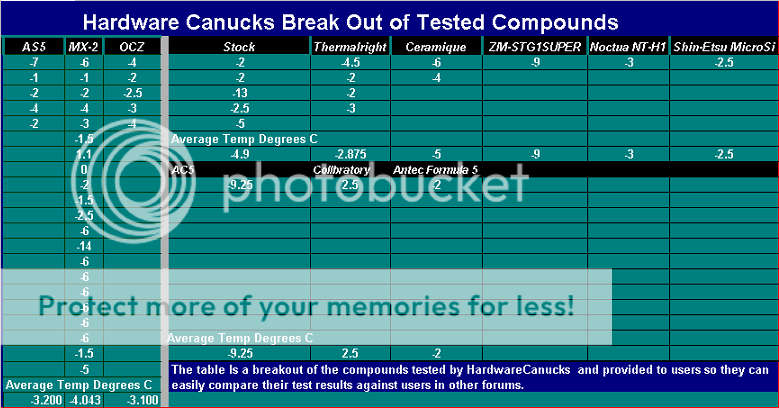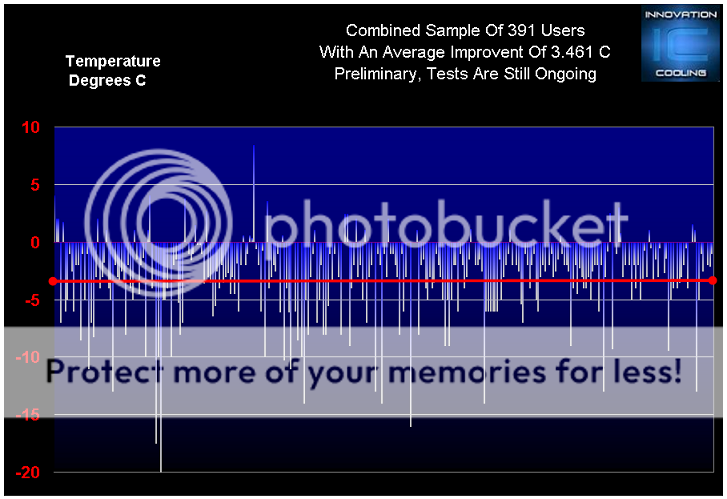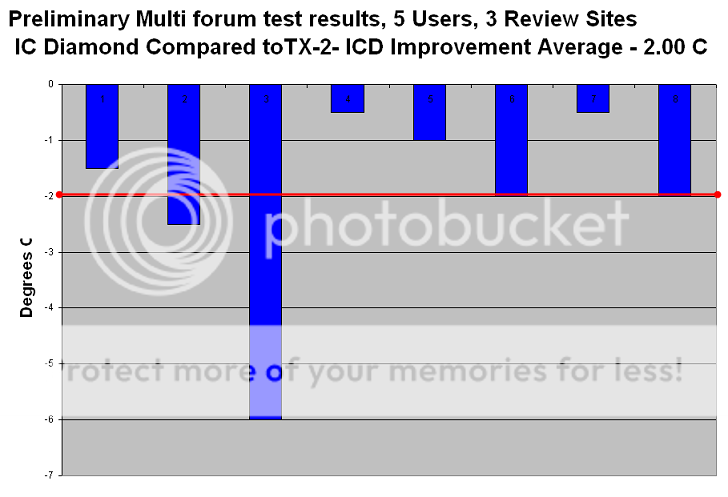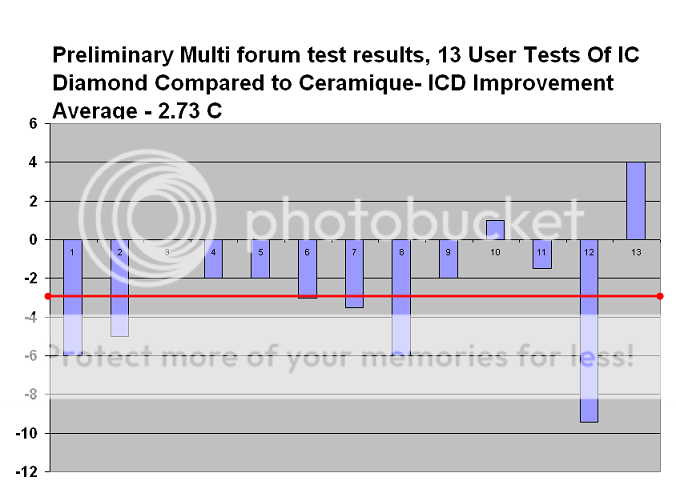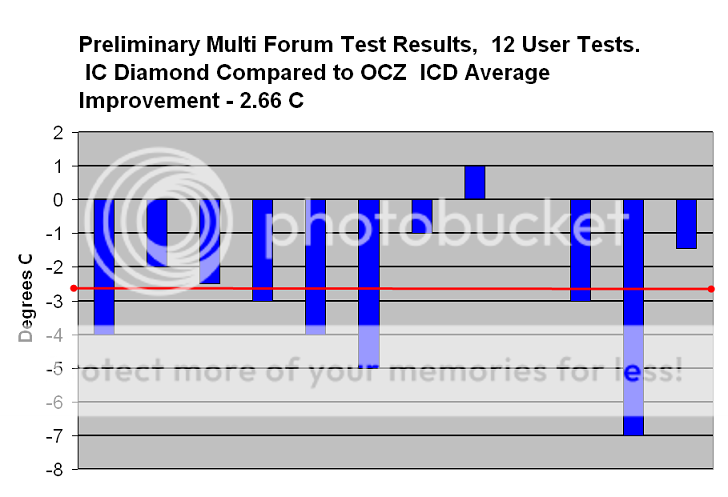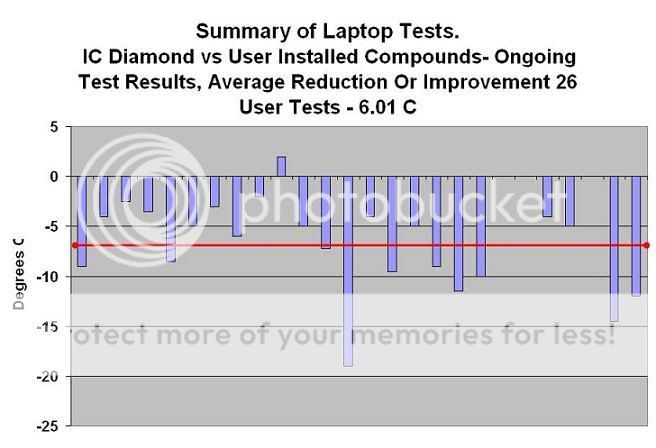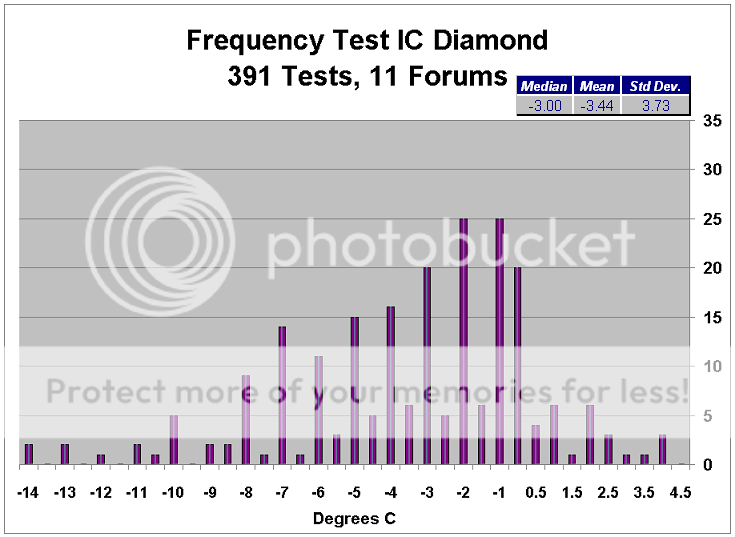This is the final report for HardwareCanucks IC Diamond Test results.
The group as a whole averaged a little higher than the overall averages, this could be a reflection of the groups preferred choice of comparison compounds. General enthusiasm was high, resulting in the highest return rate on results to date (68%).
I appreciate the effort involved in remounting sinks and the time involved in testing and reporting results. The great feed back from the people on the tests has helped us to improve our marketing message and to refine the application and troubleshooting feed back to our customers.
Special thanks to Nadeem for his organizational efforts in initiating the giveaway and sample mailing.
Thanks to all that participated and thanks to HardwareCanucks staff for the opportunity.
This thread is not closed, any and all updates, new results are appreciated
Andrew
NOTE ON COMPARISONS
When comparing results more credence should be given to larger sample sizes, smaller less so.
1-5 samples 1 or two tests can flip results either way so usually get thrown onto the miscellaneous group.
6-10 samples may start to indicate trends but can be heavily influenced by outliers and so are lightly weighted other than a general trend indicator
11-20 samples - Starting to develop more of a confidence in the trend direction.
20-30 samples - Confidence level improves.
30+ Samples - High degree of confidence
The laptop tests are from Notebook Review and help illustrate the expanded range of IC Diamonds use in in different applications. The VC/GPU tests across multiple forums I am in the process of breaking out and including those done here will be added as a final chart here at some point. The higher delta temps is due to no IHS and a smaller die contact, providing higher heat fluxes, hence the higher temp differences along with other factors such as compound failure due to the high thermal loads and higher % of generic compounds.
Bell Curve Notes
About half the data is reported in round numbers and approximately 50% of the total numbers were fractional numbers, so to include all numbers in the set I rounded the fractional numbers to the nearest ½ degree. This had a minimum impact on the overall numbers, for instance the mean dropped less than 2/100th’s of a degree.
Notes: IC Sampling Vs. Individual Tests
Innovation Cooling elected to use this more or less unique method to introduce our products as the review cycle runs like molasses for thermal compounds, 10 -12 for ICD in the last 2 years with many comparisons already obsoleted due to new product cycles.
Hardware reviews serve an important function along with observations of user experiences allow individual users to either consciously or unconsciously mentally benchmark results. Our problem was there were not enough reviews to to make comparisons on as compound comparisons are notoriously tedious vs. heat sink or other hardware.
Single tests , individual or even those done by Innovation Cooling are anecdotal in nature subject to limitations of methodology. While most pursue the most rigorous test procedure possible they still encounter fluctuations of several degrees C between tests/reviews.
Why does every test come to a different conclusion? The problem is that their sample size = 1.
Even collecting multiple readings the cluster size is = 1. An individual can collect all the data readings off one system, and will still have almost
no statistical power (In statistics this is known as
"Intra-Sample Cluster Correlation")because the test set up is dominated by methodology. This is a problem not only in paste reviews, but in other hardware reviews, heat sinks, etc. as well.
In the final analysis methodology ends up defining the final placement of all compounds- All test methodologies fail to take into account things that have a major impact on paste performance. For example the mounting system along with mechanical contact between IHS and sink as evidenced with our independent contact/pressure testing. Variability was very high on the contact results with perhaps 1 in 10 having any thing near what you might call full contact, even on those with lapped components.
In considering pressure related to mounting hardware some pastes perform relatively better under poor mounting, others perform relatively better under good mounting (viscous ones such as ICD). Considering ICD - people that had poor results with ICD had very poor mounting. Once they improved that mounting, ICD did considerably better. Of course, so did their old paste. But ICD improvement >> old paste improvement. Generally, this resulted in ICD>old.
In summary, sample size = 1 tells little. . Sample size matters!
ICD has been extensively tested by 391 independent users in 11 forum groups data that is compiled with real world, real users test results
Final



